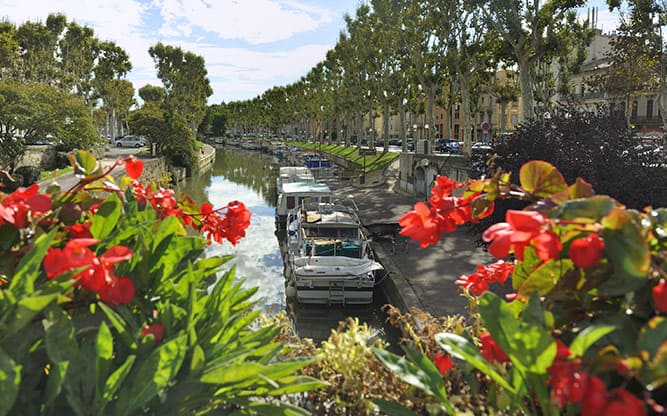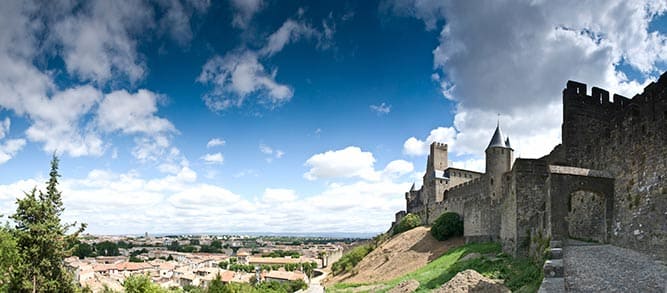Life in the Languedoc is like nowhere else in France. A thriving wine region with snow-capped mountains, spectacular beaches, fascinating history and gastronomic dining at every turn, the choices are endless.

Languedoc-Roussillon is a former province of France made up from five departments: Lozère, Gard, Hérault, Aude and the Pyrénées Orientales. In 2016 Languedoc combined with the Midi-Pyrénées to create the new administrative region of Occitanie.
The name was inspired by the historical region of Occitania, created to show where the Occitan language was spoken in the south. Despite it being a part of Languedoc’s ancient history, going back as far as the first Troubadours in the 11th century, Occitan is still taught today in some of the region’s schools.
From its historic roots to cosmopolitan city centres in Montpellier and Perpignan, Languedoc’s diversity is tremendous. Whether you’re looking for an energetic hike exploring Cathar castles or hidden lakes, a weekend of skiing or white-water rafting in the Pyrénées or a relaxing beach holiday at a Mediterranean resort, the variety of this region makes it an excellent holiday destination.
Table of Contents
Perpignan: the centre of the world?
Perpignan is the capital of the Pyrénées-Orientales department and where Dali proclaimed the centre of the world to be. Art lovers should to visit the Centre de Sculpture Romane for an acclaimed selection of Romanesque sculpture, but those preferring a gastronomic treat should head to La Galinette. Using local ingredients and vegetables from the chef’s garden, it has a very good reputation despite not being in the most upmarket part of Perpignan.
Another must-visit place in this department is Saint-Cyprien, which is one of the most coveted locations to own property in the region. The fine sandy beach and holiday atmosphere can compete strongly with resorts along the Riviera, and there are plenty of villas, apartments and hotels that offer direct access onto the beach.
Carcassonne: music and medieval magnificence
Summer in Languedoc just wouldn’t be the same without the famous Carcassonne music festival, one of the best in France. World-renowned artists like Keziah Jones and Morcheeba are performing in 2017, but there are other musicians taking the stage, as well as dance, opera and theatre shows. While the festival attracts many, most tourists in this area come to experience La Cité, the old part of this real-life, fairy-tale castle.
Meander through the cobblestone streets of La Cité, browse the gift shops, explore the castle and stop for a spot of lunch in the shady hidden garden of Les Terraces de la Cité. With the entrance slightly off the beaten track of the main square it is often less crowded than some of the other restaurants.
Head to Carcassonne Plage at Lac de la Cavayère for a day at the beach with shady areas, swimming and even a forest adventure park for the kids.
Montpellier: a capital choice
The fastest-growing city in France, Montpellier is the capital of the Hérault department. During the summer, the vibrant Place de la Comédie, at the heart of Montpellier’s dynamic centre, is filled with street performers, musicians and bustling markets, but the city also offers all kinds of cultural and historical attractions, as well as decent shopping and fine dining options.
Take the city’s winding back streets from the Place de la Comédie to the old town of l’Ecusson. Highlights of this historic quarter include the Porte du Peyrou, a 17th century arch, at one end of the Jardin de Peyrou, and the Place Royal du Peyrou, a stunning tree-lined esplanade.
In terms of eating out, the city has plenty choices, such as the Petit Jardin, a gastronomical delight. Here the quiet patio garden seems a million miles from the city centre and al fresco evening meals are warmly illuminated by pretty lighting.
Nimes: marvel at a Roman masterpiece
The Pont du Gard, an ancient Roman aqueduct which lies between Avignon and Nimes, is an engineering masterpiece. Taking the time to walk up some of the surrounding rugged hills is well worth the extra effort for spectacular views of the aqueduct.
Stop for a light lunch at Les Terraces. This little restaurant by the Gardon river provides Mediterranean fayre with the Pont du Gard just a glance away. It is a spectacular way to spend a midday pause from sightseeing and sunshine.
Corbières: explore the biggest wine region in Languedoc
Languedoc is the largest wine region in France. It produces three times as much wine as Bordeaux and home to 18 AOCs (“Appellation d’origine contrôlée”). Out of these, Corbières, in the foothills of the Pyrénées, is the biggest and covers around 12,000 hectares in the Aude and Pyrénées-Orientales departments. It is renowned for its hot, dry climate, diverse landscapes, wild, natural surroundings and scrubby Mediterranean vegetation known as “garrigue”.
When visiting this region, stopping off in Lagrasse can provide a spectacular visit to its Benedictine Abbey and an afternoon of sunshine and swimming in the river Orbieu, a favourite summer pastime of the locals.
Narbonne: a favourite with the French
Narbonne is home to some of the best beaches in Languedoc and it is a popular summer destination for the French. The Canal du Robine runs through the town centre and connects with the UNESCO-protected Canal du Midi, which meanders its way through the region to Toulouse.
Take a trip to Le Château l’Hospitalet for some of the finest dining in the region. This restaurant – also a hotel – is surrounded by vines and welcomes famous jazz stars for four nights during the summer who perform outside during dinner. Attracting big names like Norah Jones, this is a unique restaurant with a wonderful ambiance.
Bages: admire pink flamingos
Around twenty minutes south of Narbonne, Bages lies on a finger of land that’s surrounded on three sides by the Etang de Bages. This unspoilt village is a haven for peace and quiet. Here colourful patchwork stone town houses overlook the blue lagoon-like waters, which are also home to striking flocks of pink flamingos and small, traditional fishing boats.
Gruissan: for golden sands and pink seascapes
Bages is not far from Gruissan, which has one of the biggest stretches of golden beach in the area – and was where some of the film Betty Blue was filmed.
While you’re in the area stop for lunch at La Cambuse du Saunier, where a gastronomic lunch will be savoured while overlooking beautiful pink salt flats, which seem to stretch as far as the eye can see.
If you are looking to buy property in Languedoc, now in the region of Occitanie, search for properties for sale at www.home-hunts.com. To speak with a consultant directly about other suitable locations in the area for your real estate criteria, call +33 (0)970 44 66 43.




